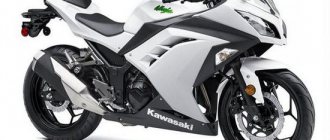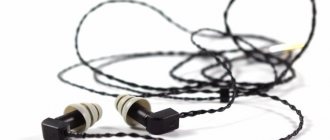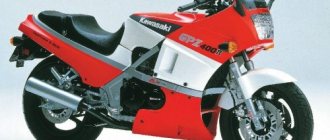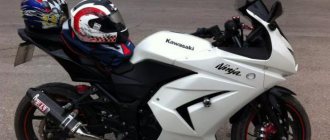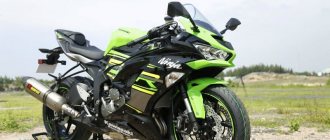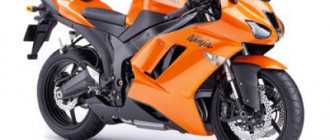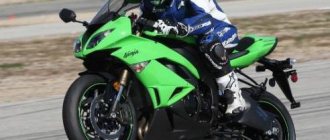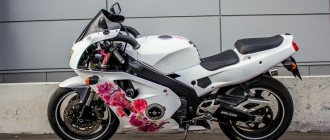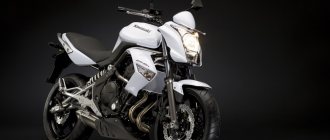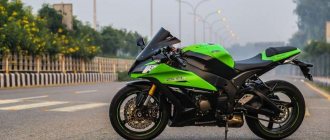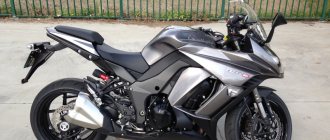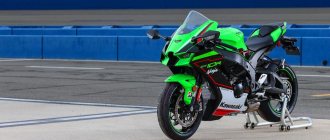This model replaced the legendary Kawasaki Ninja 250 P, but the latter never left the scene. Firstly, the new motorcycle from Kawasaki has a fuel-injected engine. The motorcycle also has a wider rear wheel, and it has lighter grip. However, overall the bike has not changed much compared to the 250 model.
The Kawasaki Ninja 300 is perfect for those who love relatively high speed: the bike can accelerate to 177 kilometers per hour, and it accelerates to 100 in 6.5 seconds. In addition, the motorcycle is not deprived of a bright design, which is generally similar to the design of the Ninja 250 R.
Dimensions and weight
The motorcycle is of average size for a sports bike. And compared to the average cruiser, it is absolutely tiny. The length of the bike reaches only 2015 millimeters. Its width is 715 millimeters. The height of the motorcycle itself reaches 1110 millimeters, while its height at the saddle is 785 millimeters. Wheelbase dimensions are 1405 millimeters.
The curb weight of the bike reaches 172 kilograms, but for versions with ABS it is 174 kilograms. This is a small weight and corresponds to the class of a motorcycle. Thanks to its relatively low weight, the bike is more maneuverable than many of its classmates of more impressive size.
Operating experience
Having analyzed popular reviews about the Kawasaki Ninja 300 online, we have compiled a list of features noted by bike owners:
- The dynamics allow you to drag from a traffic light with cars up to 300 - 350 hp. and win.
- Sensors of various systems are the weak point of the motorcycle; they will have to be serviced frequently.
- The controls are soft and the throttle is too sensitive.
- Errors when switching and opening the valve are forgiven by the slipper clutch.
- The mirrors on the Kawasaki Ninja 300 are set too close to each other.
Chassis and brakes
The frame of the bike has a diamond shape. It is made of steel, tubular. The steering wheel is small, as befits a sports motorcycle, and handling it on the road will be easy, unless, of course, this is the first time a person has ridden a bike. In general, sports options are generally not suitable for those who have never ridden motorcycles before.
The rear suspension is pendulum, similar to Uni-Trak. Its stroke is 132 millimeters. The front suspension is represented by a 37 mm telescopic fork with a stroke of 120 mm.
For the rear brakes, the motorcycle has a disc with a diameter of 220 millimeters and a two-piston caliper. At the front, the brakes are represented by a single disc with a diameter of 290 millimeters and a two-piston caliper.
Kawasaki Ninja 300 technical specifications
The engine is a 4-stroke, in-line, 2-cylinder unit with water cooling. The volume is 297 cubes, allowing you to squeeze 37 hp out of it. on the wheel and 24 meters of torque. Such good performance was achieved through the use of an injection system with dual throttle valves. The latter allow the engine to remain elastic throughout the entire speed range. The heart of the bike is enclosed in a steel diamond-shaped tube frame, giving impressive rigidity to the entire structure, while the motorcycle weighs only 172 kg.
Dynamics – stated acceleration to 100 within 6 seconds. Decent performance for the class and excellent for driving in the city. With such dynamics, leaving most of the traffic at the traffic lights will not be difficult. At the same time, the Kawasaki Ninja 300 has a maximum speed of approximately 180 km/h. The indicators are average, but there is something to be surprised about. The motor has an impressive torque, comparable to larger engines. At a speed of 100 km/h and in 6th gear, the motorcycle accelerates quite easily when the gas is opened. That is, you can move along the highway or in traffic without constantly switching and spinning the engine up to 10 - 12 thousand revolutions to speed up.
The transmission is a standard 6-speed, with the function of switching to neutral when coming to a complete stop. Drive – chain.
The suspension is represented by a 37 mm telescopic fork at the front, and a swingarm with a single Uni-Trak shock absorber at the rear.
It all stops thanks to a 290 mm disc at the front and a 220 mm disc at the rear, through the force of two-piston calipers. For an additional fee, you can install the latest generation ABS system from Nissin on the Kawasaki Ninja 300.
When considering the technical specifications of the Kawasaki Ninja 300, it is worth mentioning the slipper clutch system. This system comes straight from motorsports and allows you to maintain rear wheel traction when downshifting.
Advantages
Considering the Kawasaki Ninja 300 technical characteristics and other features of the model, the following advantages can be highlighted:
- A powerful and flexible motor is reliable, unpretentious, which means we can talk about low operating costs.
- From a distance and up close, the motorcycle does not look stripped down or flawed, thanks to its similarities with its older brothers.
- Even a tall rider can sit comfortably on the bike.
- With careful driving, consumption can be a measly 3.5 liters.
- Excellent handling, together with safety systems, make it safe for novice motorcyclists.
- Possibility to add ABS function to Kawasaki Ninja 300.
- The air exhaust system from the radiator is designed in such a way that the heated air does not reach the rider - a useful feature, especially in summer toffees.
- There is a large selection of custom and factory tuning that allows you to turn a standard model into a Kawasaki Ninja 300 as in the photo.
What didn't you like about the Kawasaki Ninja 300?
- When traveling long distances, you have to twist into a shrimp position so that the oncoming air flow does not rip you off the saddle.
- The exhaust sound is very buzzing, reminiscent of a lawn mower - not at all consistent with the fast appearance of the motorcycle and its capabilities.
- The engine is demanding on the quality of fuel and lubricants, so refueling at dubious pumps or skimping on oil can soon lead to unpleasant and expensive engine repairs.
Unprecedented success of Kawasaki Ninja
The first 250cc Ninja model that the company released was an overnight success. Having an impeccable stylish design, the Ninja simply could not help but please both beginners and avid motorcycle lovers due to its decent filling and engine capacity, which can be compared with popular machines from Japanese manufacturers. However, the company itself described the bike as “ideal for beginners.”
The launch model Ninja 250R was created in 1986 and was designed as the first in a line of sports motorcycles suitable for asphalt and paved roads. The Internet resource MotorcycleUSA.com, which enjoys unprecedented authority among Americans, described the model as the most successfully sold, the number of fans of which is growing every year. In addition, in the USA Ninzdi did not find a single worthy competitor. However, it was not the design that received the most enthusiastic customer reviews, but the powerful engine, design, compactness of the chassis and ergonomics. The creators set a single goal when developing the Ninja - to produce the best circuit racing motorcycle in its category, and they succeeded.
Updated samurai
This is how we can briefly describe the Ninja 300 - a modernized 250 model, the history of which begins in 2012, when the Japanese creators decided to release a sports and at the same time inexpensive motorcycle. The machine is characterized by an injection engine, an enlarged cylinder and a modernized lightweight piston.
The engine capacity has also undergone changes, which has increased significantly compared to the previous model and amounted to 296 cubic meters. cm, providing a power of 39 hp. The announced two-cylinder model is also characterized by reduced fuel consumption and an updated ABS system. Kawasaki also took care to equip its new brainchild with high-quality parts and a dense plastic surface, but Korean tires represent its weak point. The design of the model is thought out to the smallest detail, giving the silhouette of the motorcycle an impressive look.
Thanks to its excellent stability and easy gear shifting, the 300 Ninja is perfect for beginners who want to acquire basic motorcycle riding skills, and high-quality disc brakes ensure a safe ride on any road. The motorcycle is specially created for European roads and is capable of reaching speeds of up to 190 km/h.
Owners' opinions
We all know that no matter how beautiful the device looks, before purchasing it, you need to read the reviews of motorcyclists who managed to purchase the model they liked. Owners characterize Ninja bikes as a very fast option, capable of accelerating up to 180 km/h, so they recommend spending money on buying a helmet. Some car enthusiasts note the rather expensive spare parts for Kawasaki and focus on safety, because driving over 150 km/h can only be accomplished by experienced bikers. Others do not notice the shortcomings at all, praising the motorcycle’s fast acceleration and low fuel consumption.
When purchasing one of the Kawasaki bikes, you must remember that you are getting a high-quality motorcycle from a reliable Japanese manufacturer that will be able to meet all your expectations, delivering only positive emotions from owning the machine.
What else you can read:
- Jeep Grand Cherokee 2015-2016 – The flagship of the American automobile industry
- Lifan X60 2021 – Chinese conservatism
- Renault Duster 2021 – Charismatic “duster” in a new wrapper
- Lada Priora 2021 – “Low Taz – pleasing to the eye”
- Lada Vesta SW Cross 4x4 – Our people love all-wheel drive
- Skoda Octavia 2021 – All the best from Audi
- Peugeot 3008 2021 – Ready for debut!
- Nissan Beetle 2021 – A small car with big ambitions
